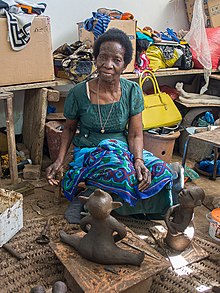
Back Макондэ Byelorussian Маконде Bulgarian Macondes Catalan Makondové Czech Makonde Danish Makonde German Μακόντε (φυλή) Greek Makondoj Esperanto Makonde Spanish Makondet Finnish
Wamakonde | |
|---|---|
 | |
| Regions with significant populations | |
| 1,200,000[1] | |
| 240,000[1] | |
| 3,764[2] | |
| 1,400[3] | |
| Languages | |
| Kimakonde, Kiswahili, English, Portuguese, French | |
| Religion | |
| In Tanzania:
Minority Ancestor Worship[5] In Mozambique: Majority Christianity[4] | |
| Related ethnic groups | |
| Person | Mmakonde |
|---|---|
| People | Wamakonde |
| Language | Kimakonde |
| Country | Umakonde |
The Makonde are an ethnic group in southeast Tanzania, northern Mozambique, and Kenya. The Makonde developed their culture on the Mueda Plateau in Mozambique. At present they live throughout Tanzania and Mozambique, and have a small presence in Kenya.[7] The Makonde population in Tanzania was estimated in 2001 to be 1,140,000, and the 1997 census in Mozambique put the Makonde population in that country at 233,358, for an estimated total of 1,373,358. The ethnic group is roughly divided by the Ruvuma River; members of the group in Tanzania are referred to as the Makonde, and those in Mozambique as the Maconde. The two groups have developed separate languages over time but share a common origin and culture.[8]
- ^ a b John Ndembwike (October 2009). Tanzania: Profile of a Nation. Intercontinental Books. pp. 149–. ISBN 978-9987-9308-1-4.
- ^ "2019 Kenya Population and Housing Census Volume IV: Distribution of Population by Socio-Economic Characteristics". Kenya National Bureau of Statistics. Retrieved 24 March 2020.
- ^ PeopleGroups.org. "PeopleGroups.org - Makonde of Mayotte". peoplegroups.org. Retrieved 2021-08-26.
- ^ a b c Sousa., Santos, Ana Margarida (2011). History, memory and violence : changing patterns of group relationship in Mocimboa da Praia, Mozambique (PDF). Oxford University.
{{cite book}}: CS1 maint: multiple names: authors list (link) - ^ Service, Islington Education Library (2003). "Makonde 'Tree Of Life' Carving, Tanzania | Object Lessons - Ceremony & Celebration: Family & Culture". Islington Education Library Service. Retrieved 2021-08-26.
- ^ Service, Islington Education Library (2003). "Makonde 'Tree Of Life' Carving, Tanzania | Object Lessons - Ceremony & Celebration: Family & Culture". Islington Education Library Service. Retrieved 2021-08-26.
- ^ Cite error: The named reference
UNHRCwas invoked but never defined (see the help page). - ^ Appiah, Kwame Anthony; Gates, Henry Louis, eds. (2010). Encyclopedia of Africa. Vol. 2. Oxford New York: Oxford University Press. p. 115. ISBN 9780195337709.
© MMXXIII Rich X Search. We shall prevail. All rights reserved. Rich X Search